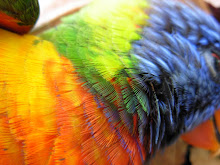This is an eastern Noongar word and one taken from Cliff Humphries (1910 - 1998). His word for bark was similarly configured, it being yorl.
It seems to me that these two words are similarly composed and describe something in Noongar terms for the outer skin covering that beneath it.
What lies beneath this 'Noongar metaphoric skin' is what I want to discuss in the following.
It seems to me, that there is the constant anxiety by some Noongar I know, of the opaque quality of their untanned skins, as if their skins are the central substance of their being.
But this belief and opaque anxiety is not only theirs, but it is an anxiety for many human communities throughout the world.
In India, in the land of the mystic, many Indians advertise their marriage suitability based on their "wheatish" appearances.
And here in Australia, until very recent times, generations of the pale-skins among us laid out on beaches (solar barbecues) till we were cooked and blistered, hoping and waiting to be tanned.
Still today some risk all, sunning themselves in solarium's hoping for the same result.
Why this want to change one's appearance?
Why this want to be something one is not, and to change the skins we wear?
For the Noongar of old their skin was worn covered.
Beside their treasured worabwok (grey doe kangaroo skins) they wore, their human skins were rubbed and smeared with animal fat, in particular emu, kangaroo and whatever else they could put their hands on.
Sometimes mixed with the fat was red ochre, and their bodies were said to glisten.
I don't know whether this was singularly a ritualised covering, or whether it was used in more general attire, but their skin, even when bwokbert, uncovered and naked, was dressed against the wind and rain.
But was it just decoration or did it cover what was revered within?
The yorl of the tree was used as a funnel to dish out and carry water.
It was the Noongar equivalent of the Wadjalla bowl and Wongi yandy, or carrying dish.
So the yorl was the vessel that was used to carry water from the ngaamaa rock water hole, or ngoora, water soak, or the boorna-bip, water trees to wherever the family were camping.
The yorl was both a dish and the bark of the tree and when Noongar obtained water from the roots of some eucalyptus species, it was yorl they removed to suck or carried with them to keep the water within.
But it was the water within that preserved their life, it was, I suspect, what was within that mattered most.
And yet the bark was not simply something discarded, but something revered.
For the Noongar nop when first born, they were rubbed with the bark ash of the maang-art or acacia accuminata.
At life's end they were buried with this same bark and ash.
The bark of this tree, the jam tree, was burnt in the grave before the body was interned.
The bark was thus revered and signified for those Noongar present something of beginnings and endings, or was it the continuity of something much larger?
Human skin was dressed in oil and at birth in bark ash, and so too in death. Something was being said in these rituals, something that identified a meaning that went beyond the skin, to what lay within it.
In the decorations that men and women wore in their dances, something of the power of their borongaa or ritual being was infused and marked atop, and within and beneath the skin.
In my Masters I had written about the Wadjalla preoccupation with skin.
I quoted the work of Bates and written on where I thought she had erred in her translations.
I had written:
There is a Nyoongar word for he who was selfish in providing meat and that was Daadjert. I argue, it is an abbreviation of daadj-bert. The word daadj-bert means: “meat-without”. Bates’ (1992: 120) link between “half-caste” and “daadj-bert” is a wrong translation of this word. Daadj-bert infers the breakdown of the traditional sphere of reciprocity, marriage and classificatory skin and relationships between individuals. It has nothing to do with the genes, mixed blood or of being “half-caste”, as Bates and the audience of her early writings understood it. Bates wrongly inferred that the “full-blood” Noongar was antagonistic toward the Noongar of mixed ancestry because of the singular reason of their mixed blood. I suspect the issue of Noongars of mixed ancestry was Bates’ problem, not the early Noongar. Daadjert merely identified the lack of Noongar dowry “meat promise” through the Noongar custom of daardjalak – “with meat”. Daadjert was the opposite of this. Daadjert brought about the breakdown of the social networks that Noongars had relied upon for millennia. The breakdown of daadjalak eroded Noongar confidence in their traditional networks of self-sustenance. Daadjert forced Noongars into poverty, not as Bates implies through them being lesser human beings (less than full bloods) or half-castes of mixed ancestry or blood (Humphries and McCabe 1994)"
The issues of skin and what it communicated to the 'Noongar wearer' of old was different, I think, to the way it absorbs us 'the wearers' of the present.
The anxiety of the present day seems absorbed in the qualities of identities, or beauty, ignoring the deeper quest to understand and accept what life lies within us, and what the ngoorl, or yorl signifies and carries with it between life and death and beyond.

No comments:
Post a Comment